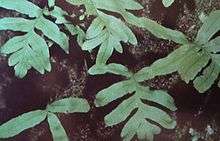Polypodium australe
| Polypodium australe | |
|---|---|
 | |
| Scientific classification | |
| Kingdom: | Plantae |
| Division: | Pteridophyta |
| Class: | Polypodiopsida/Pteridopsida (disputed) |
| Order: | Polypodiales |
| Family: | Polypodiaceae |
| Genus: | Polypodium |
| Species: | P. australe |
| Binomial name | |
| Polypodium australe Fée | |
Polypodium is derived from the Greek Polus, many, and podion, small foot, since the rhizome bears numerous roots. Australe comes from the Latin auter, wind of the south, for in Europe, this species grows more particularly in southern France. The common polypody is medicinal plant known since the times of Dioscorides, and its rhizome is used against cough and liver diseases.
Description
Perennial. Rhizome elongate, often above ground, densely covered with rusty scales. Fronds distich, 5-30 cm, glabrous, deltoid in outline; petiole yellowish green, shorter than the pinnatipartite limb. Segments 5-28 on each side; margin dentate, marked with a strong midrib. Sori round, 2-4 mm in diameter, orange-yellow, arranged on each side of the midrib of segments.
Fructification
February-July.
Habitat
Shady rocks.
Distribution
Coast, lower mountain.
Geographic area
Syria, Lebanon, Palestine, Tunisia, Algeria, Morocco.Mediterranean, Atlantic Europe.
References
Mustapha Nehmeh, Wild flowers of Lebanon,National Council For Scientific Research,1978.